Our Summer Cruise 2016
May 16 - 22 |
May 23 - 29 |
May 30 - Jun 5 |
Jun 6 - 12 |
Jun 13 - 19 |
Jun 20 - 26 |
Jun 27 - Jul 3 |
Jul 4 - 10 |
Jul 11 -17 |
Jul 18 - 24 |
Jul 25 - 31 |
Aug 1 - 7 |
Aug 8 - 14 |
Aug 15 -21 |
Aug 22 - 28 |
Aug 29 - Sep 4 |
Sep 5 - 11 |
Sep 12 - 18 |
Sep 19 - 25 |
Monday, June 13
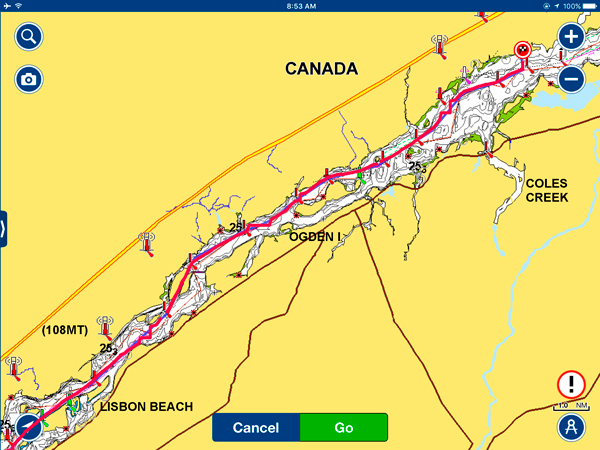 P
P
Prescott to Crysler Park Marina - 23 nm
Up and out early today for breakfast with the Three Amigos at Bobby's just across from the marina, the only game in town and they didn't open until 8:00 am. The breakfast was good and included some tasty french fries instead of the normal fried potatoes as they had a busy day Sunday.
The first of the big locks, the Iroquois, was on the agenda this morning at 9:00 am, the first opening for recreational boats. We met up with another boat just as we left the marina and traveled the few miles to the lock where we had to tie up on a short wall, rafted up two deep, while the others bought their $30 lock tickets. The Trent is more generous with their "blue" line docks than here.
We were informed that there would be a one hour wait which is not unusual. The Iroquois Lock is over 700' long and 80' wide but is a control lock used for the purposes for controlling water level. We filed into the Lock with images of the cavernous locks dwarfing those of the Trent we had seen in photographs, received two wimpy looking lines from the Lock staff and held our breath. Ten seconds later, "That's it," was called out - we had dropped four inches if you were being generous. The gates swung open and we were on our way - what a letdown, we want our money back!
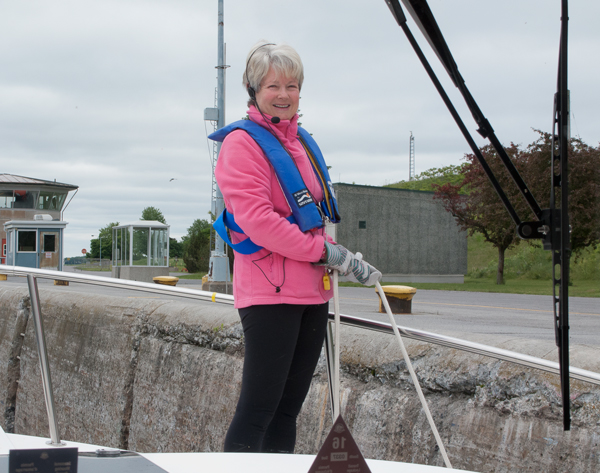
Waiting with Anticipation - Yes It Was Cold!
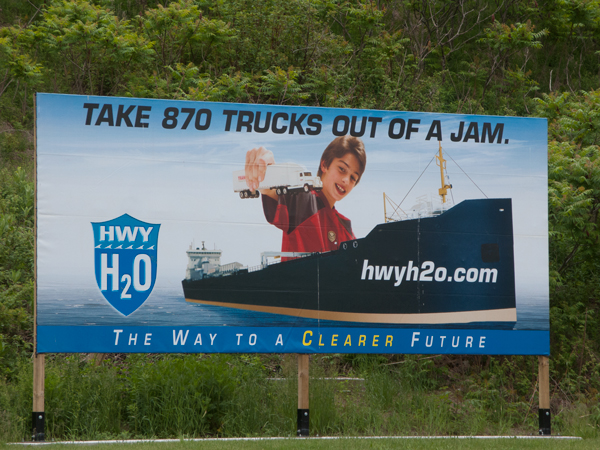
A Plug for the Efficiency of the Canal (Don't They Already Know?)
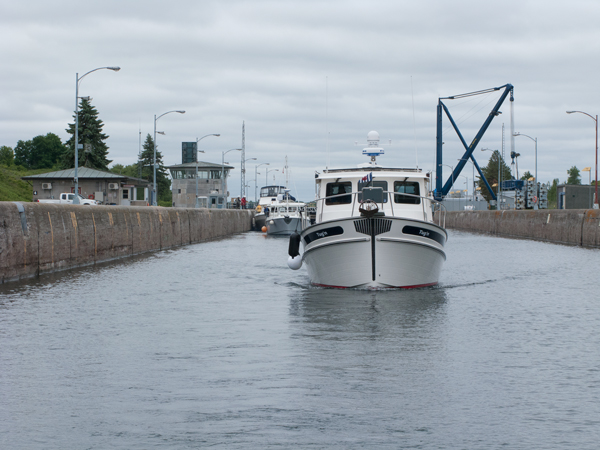
Tug'n and Wings Leaving Iroquois
While we were waiting, the other boat traveling with us told us that the Marina Port d'Escale in the Vieux Port of Montreal was on strike over their labor contract. This is the prime location for boater visiting Montreal as it is right in the historic district and convenient to most of the sights of the city. What a disaster. To make it worse the prospect of a settlement was remote. The adjacent Yacht Club was also full with the seasonal boaters ejected from the marina. We immediately started to search for spots at the other two marinas.
Today's run ended in the early afternoon at the Crysler Park Marina just past Morrisburg. It is an odd marina with a large number of docks and for once they were longer docks. The marina was sparsely populated with seasonal boats and few transients but the facilities were very good and the staff friendly. Its claim to fame must be its location just a couple of miles from the Upper Canada village, our destination for the afternoon.
The Village is an active re-creation of 19th century rural Ontario life, bringing the crafts, trades, and daily routine of the 1860s alive with more than 40 buildings and costumed interpreters. The buildings were moved here in the 1950s, when the building of the Seaway would have submerged them at their original sites. The Village was besieged by school children taking their end of school year field trip otherwise it would have been very quiet today. The interpreters were clearly feeling the strain of the day but most were still very interesting to talk about their building or craft's role in village life. Our favorites were the water-powered sawmill, the flour mill, the bakery, and the woolen mill.
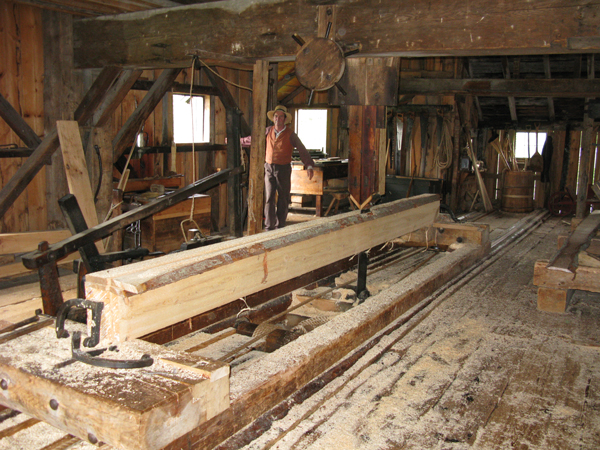
Sawmill (can exceed a band saw mill when cranked up)
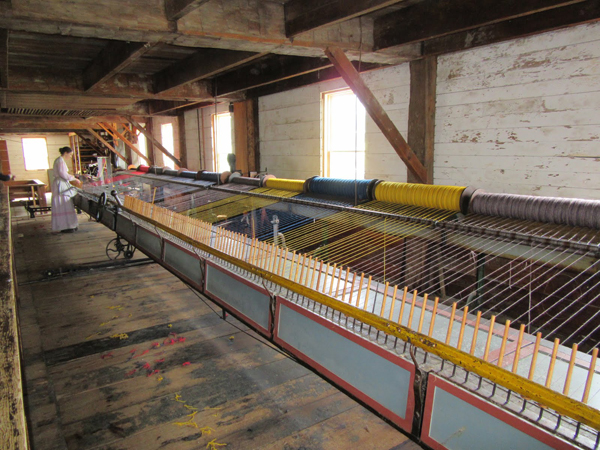
Working Woolen Mill
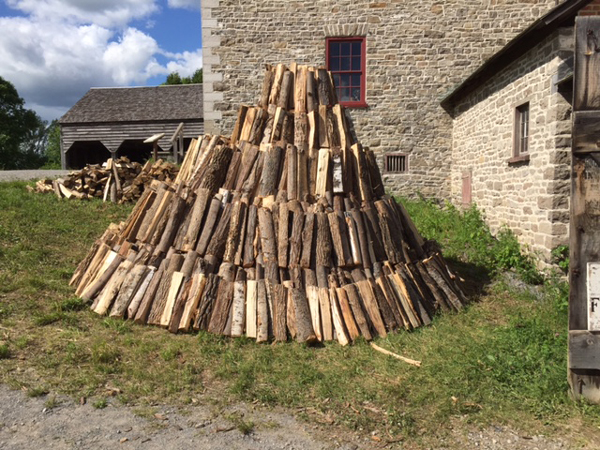
How They Stacked Cordwood in the Day
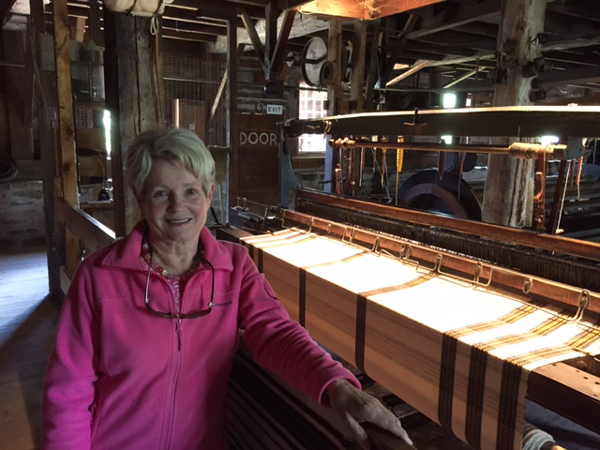
At the Blanket Loom
The cabinet maker was recently from the Isle of Wight in England and was named David Jones - what a coincidence! The rest of the group thought there were some similarities!
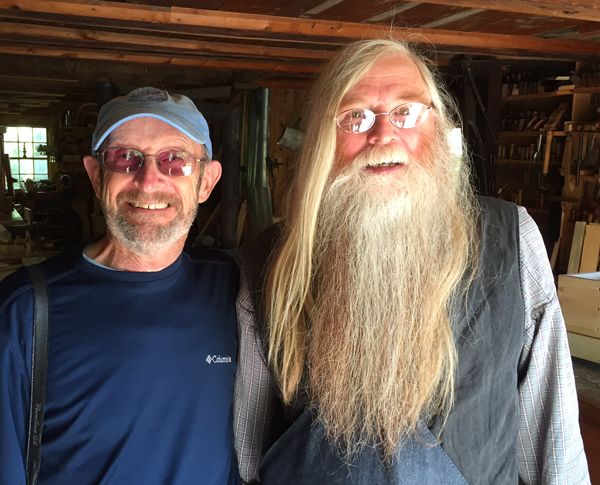
Doppelgangers??
A thoroughly enjoyable afternoon visiting the past. To do justice to the Village, plan a full day outing if you are ever in the area.
From our slip we had a clear view of the channel beyond - and the wake from passing freighters. We were lucky enough to catch two freighters passing late in the evening.
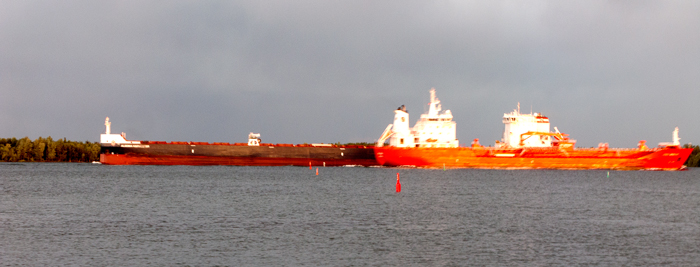
Freighters In the Night
From our limited experience in the Great Lakes, it always seemed as if there were freighters everywhere. It is not uncommon the see one every couple of hours on Lake Michigan when going North and at the major junction of Lakes Huron, Michigan, and Superior to have several in sight at one time. On the Seaway so far, they don't appear to be as frequent which is just as well as there are some tight passages and canals and they can prove to be a hindrance to us as they take priority at the Locks and can delay recreation vessels up to four hours. This year, as the season goes on, there is a new policy in place that limits recreational vessels to one locking in the morning and one in the afternoon. Fortunately, we are early enough in the season to miss the implementation of this.
Luckily, we have Automated Identification System (AIS) on our boat which allows us to see vessels way beyond visual range. From an icon on the chartplotter, we can see details of the vessel such as size, speed, location,and destination. Using the Internet, we can extend the range of AIS anywhere in the world to see what potential hang-ups we can see at locks ahead and hopefully time our departures to minimize delays.
Tuesday, June 14

Crysler Park to Salaberry de Valleyfield - 47 nm
Up early to head for the only two locks in the USA, the Eisenhower and the Snell that bypass the Long Sault Rapids. We had been warned that the recreational vessel dock was minimal and hazardous so we managed, with the AIS showing all clear, to hold position just before the lock before they let us in.
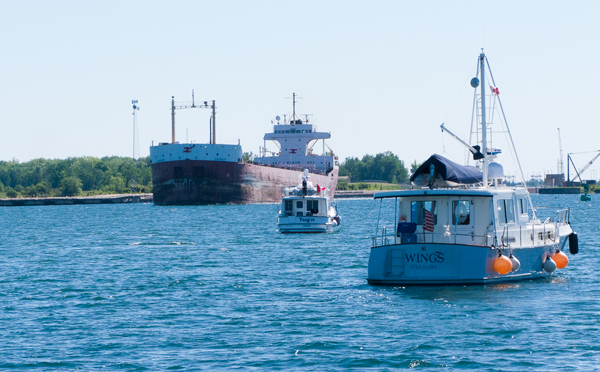
One Out, Three In
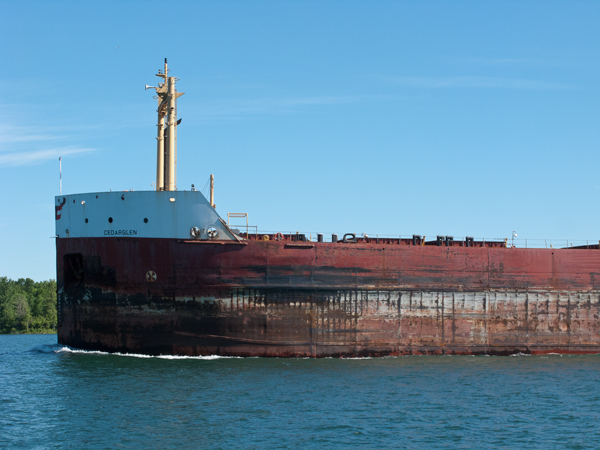
This One's Had A Hard Life!
The staff had Wings and Tug'n raft up together with lines to one floating bollard while we had our own bollard - much easier as Wings had to keeping running their engine to maintain position.
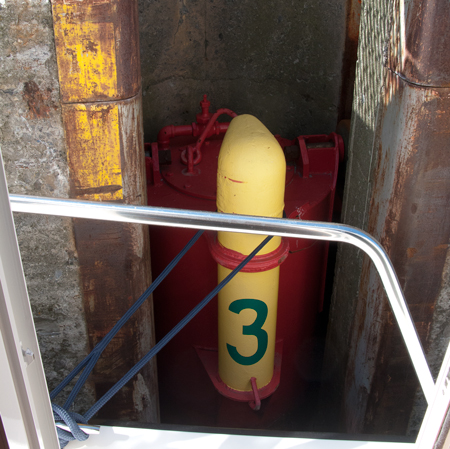
We Like These
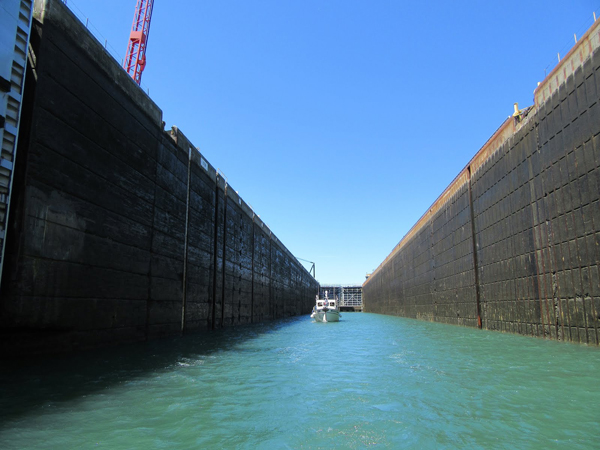
STB Leaving the Lock, Big, Eh - 36' Drop
Just a short distance further on through the Wiley-Dondero Canal we passed through the Eisenhower's sister Lock, the Snell, without too much delay and then we were in Quebec with a a long crossing of Lac St. Francis of about 18 miles to reach our destination of Salaberry-de-Valleyfield,QC - dig out the French book!
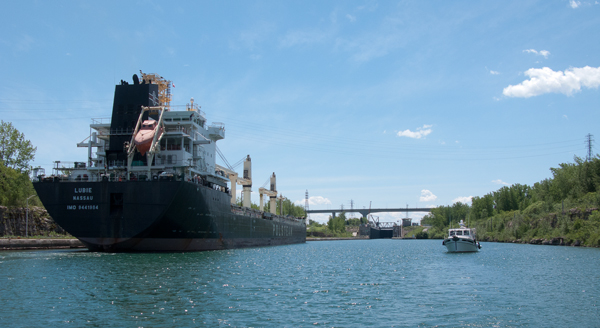
Tug'n Dwarfed by the Lubie As We Leave the Snell Lock
Along the way today, we really started to feel the effect of currents on the Seaway with anywhere from 1 to 3 knots in our favor. At times we were traveling at over 10knots at engine rpms that would normally only give us around 7.5 kts, saving us fuel.
We pulled into the Valleyfield Marina ahead of Wings and Tug'n to try my high school French out and get slip assignments and were fortunate to get a long slip in clear water. When Tug'n came in to their slip it was short, narrow and absolutely clogged with weed. Stephen managed to skillfully abort a slip entry at the last minute and both he and Wings headed for the town wall about a mile away to tie up there for the night. The Down East Guide, our Bible for the trip, didn't mention this facility but for $20, they got a good tie up along a concrete wall in the park - a very good deal.
Later in the evening, after doing some washing, a boat rinse, and a shower, we wandered to see them through a very nice downtown area to the concert in the park they were enjoying for their $20.
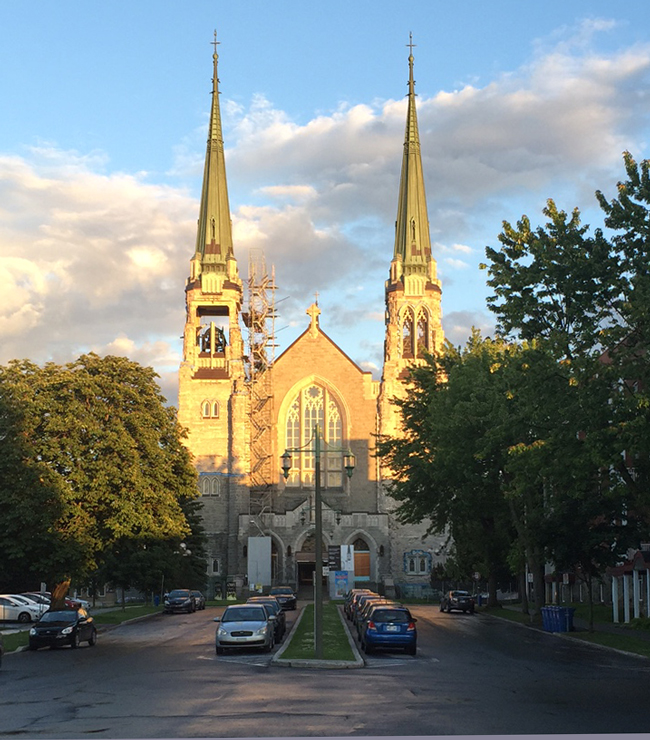
La Basiique-Cathedrale Sainte-Cecile
The Basilica is undergoing a massive restoration with the spire on the left a skeleton of its former self - compare to the one on the right. It was amazing that it could support the steeple with so much stone removed.
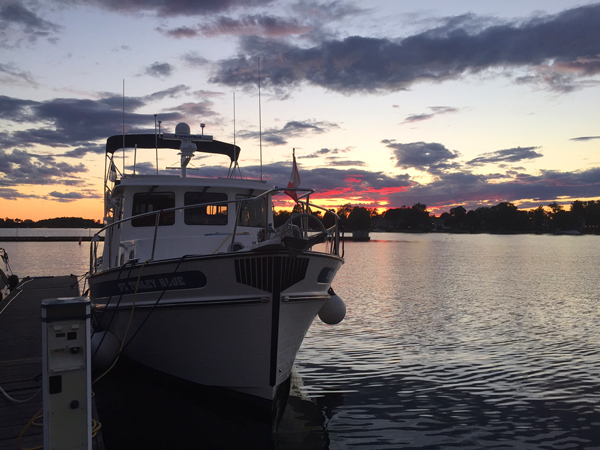
Wednesday, June 15

Valleyfield to Montreal - 44 nm
Today began early as our goal was Montreal, 44 nm away but also four locks and two lift bridges to pass under/through. The first of these was the Valleyfield Bridge where, due to some confusion on its name in the Bible, we were unable to contact the bridge operator and sat for what seemed an age trying to keep the boat close in a strong current that kept taking us closer and closer to the bridge. Finally the operator acknowledged our presence and we were through to the 12nm canal that would lead us to the double Beauharnois Locks.
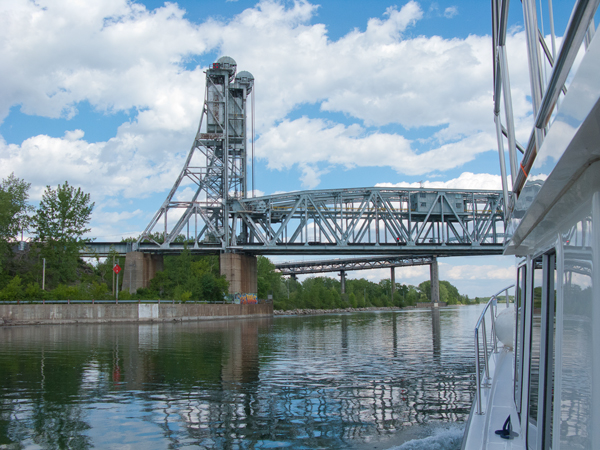
The Valleyfield Bridge
The other bridge lift was much more successful and we were at the first lock where we had an hour wait. It was then on to a long run on Lac St. Louis that has minimal depth outside of the well marked channel. Only one freighter today, really a tug-barge-tug combination that held us up for some time.
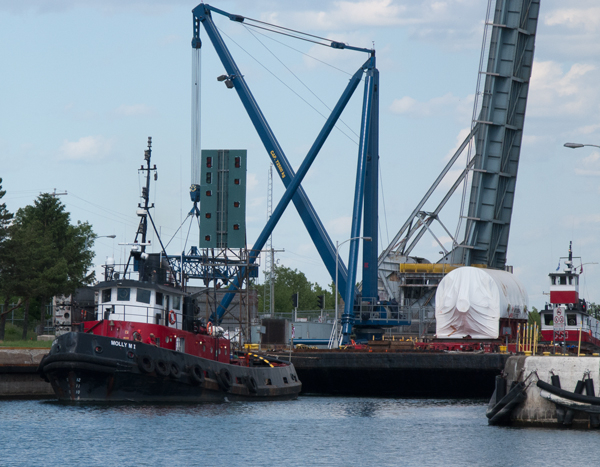
From the east end of the Lac, we entered the long canal stretch that would take us through the final locks, the Cote St. Catherine and the St. Lambert, to bypass the Lachine Rapids, a major obstacle to early travel upstream of Montreal. From there we were spit out into the strong current of the St. Lawrence as it is split by the islands that make up Montreal. Not too much notable about this stretch except the M/V Blue Moon heading upbound between the two locks to spend the summer in the Great Lakes. We saw this boat many years ago in Holland when we had the sailboat.
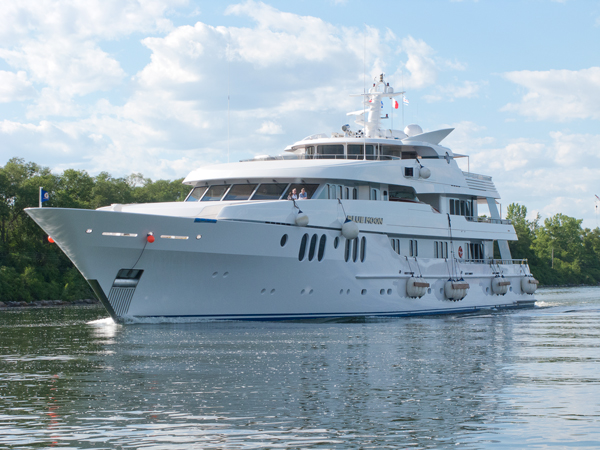
Doing It In Style and Not at $30 a Lock
Along the way we had secured reservations at La Ronde Marina on the Ile St. Helene across the water from Montreal. The Bible fails to mention this Marina but it was our only choice as Longueuil did not answer or e-mail or calls. Their website looked good so we were looking forward to getting on dry land after a long day.
To get there we had to do a U-turn from the canal across a very strong current to head southwest which would have been relatively easy except a freighter coming the other way was doing the same thing. You get a respect for current when you see a 750' freighter moving sideways at 5 knots towards you!
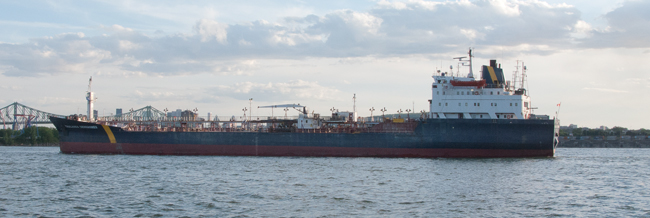
As usual, we had short narrow slips but strong currents that were the match of our thrusters. With help from the staff and nearby boaters we finally managed to get close to the dock and secure STB. More about the Marina later but here is the view from the pilothouse.
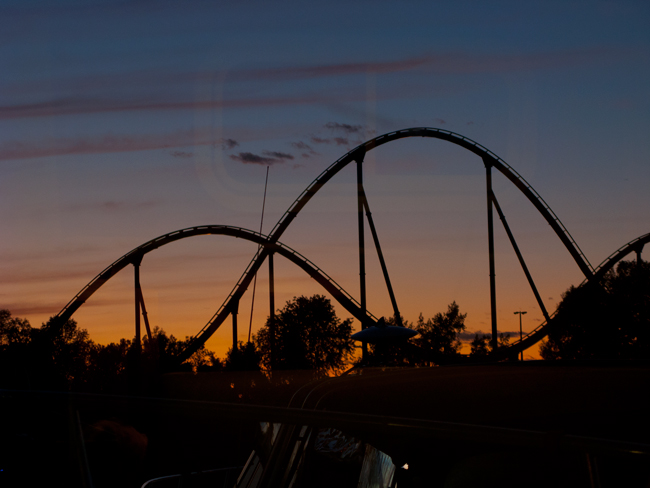
We Are Surrounded by An Amusement Park!

Classic Wooden Roller coaster at the Stern
Thursday, June 16
A beautiful day dawned in Montreal.
First a bit about the city.
Montreal was named for Mont Real an extinct volcano. Jaques Cartier was the first known European to set eyes on this feature in 1534 but colonization didn't begin until 1642. At first, Montreal was just the starting point for further exploration into the Interior but it soon became a bustling and prosperous fur trading center with ships laden with beaver pelts for the elite of Europe (the pelts were used extensively for hatmaking.
For years, the French and British battled for control of the fur trade and ownership of the region known as New France which extended from the Atlantic to the Great Lakes. The final end to the struggle came in 1760 when the French surrendered Montreal. today the population of Greater Montreal is greater than 4 million making it the second largest city in Canada and it remains distinctly French although over 35 languages are spoken. French and English predominate today, but it is truly a cosmopolitan city.
Montral has been very successful in preserving the the buidlings of Vieux (old) Montreal that have become a major tourist attraction. Round every corner one sees 17 and 18th centrury buildings alonside modern structures. It truly feels like being in France with its sidewalk cafes and restaurants. Food is a major interest in Montreal and there are over 4000 restaurants, bistros and cafes to delight any needs.
In its recent history, Montreal hosted the 1967 Expo, a Category One World Fair on the Ile St. Helene where we are staying. This attracted over 50 million visitors. Shortly thereafter, the city was home to the 1976 Olympic Games, considered by many to be one of the most successful to date.
The La Ronde Marina, where we are staying, was created for the 67 Expo and over the years has suffered from neglect and many owners. Recently, new owners have gradually been renovating the facility and it has a good seasonal base. The owners and staff are very friendly and have gone out of their way to help us during our stay. It does not have the access the other two marinas have to the city but it is only a short walk/shuttle bus to the Metro, an excellent way to get around Montreal.
That said, we were off to Montreal early in the morning to explore and met up with Jan, Fran and Stephen at the Metro while Bob took a day off as his hip was hurting. The Metro was a bargain for us at $18 for a three-day pass valid for unlimited bus and Metro travel. We got a payback the second day!
Food was calling so be stopped almost at random at one of the small cafes where Judy feasted on fruit crepes and latte will I went healthy with sausage and egg. The crepes and lattes were works of art.
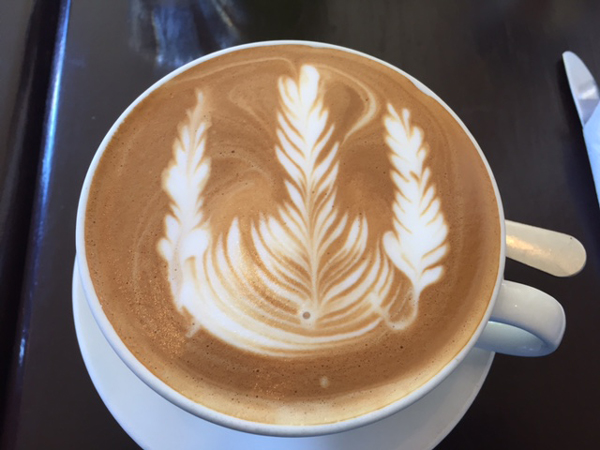
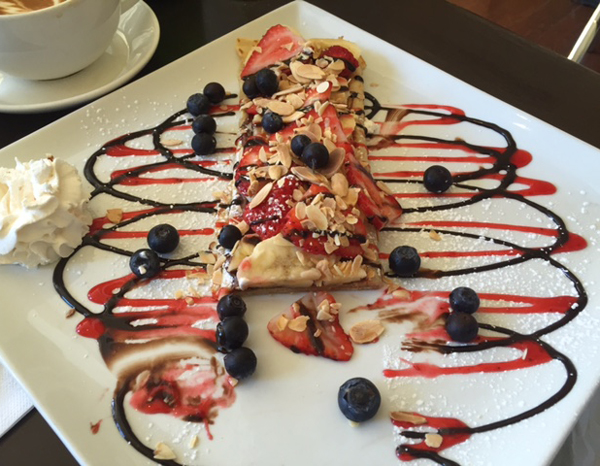
Our first stop was the oldest Chapel in Montreal, Notre-Dame-de-Bon-Secours, built in 1771 over the ruins of the first Chapel. St. Marguerite Bourgeoys, the first teacher in the colony of Ville-Marie and the founder of the Congregation of Notre Dame, rallied the colonists to build a chapel in 1655. In 1673, returning from France, Bourgeoys brought a wooden image of Our Lady of Good Help; the stone church was completed in 1678. It burned in 1754, the reliquary and statue being rescued and the church was rebuilt. In 2003, the remains of St. Marguerite were reburied in the church.
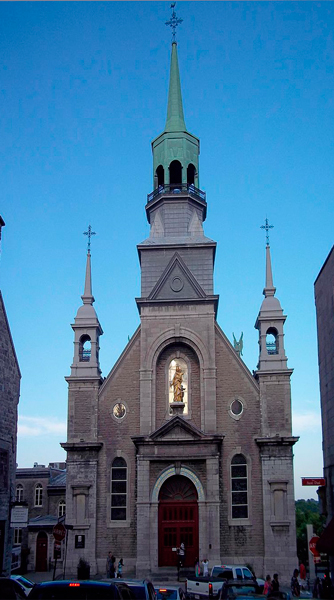
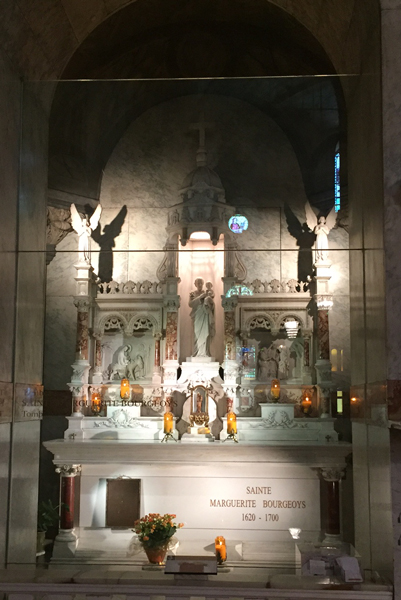
With the growth of Montreal as a port in the 19th century, the Chapel became a favourite place of prayer for sailors. The carved replicas of sailing ships made by sailors hang from the vault of the chapel as a reminder of their faith in Notre-Dame-de-Bon-Secours.
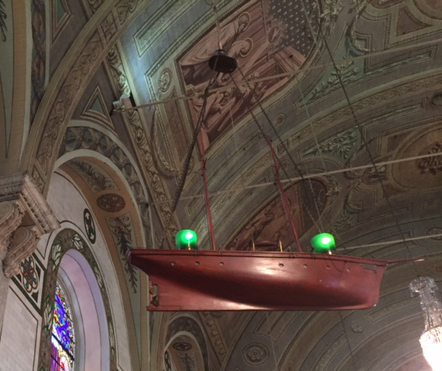
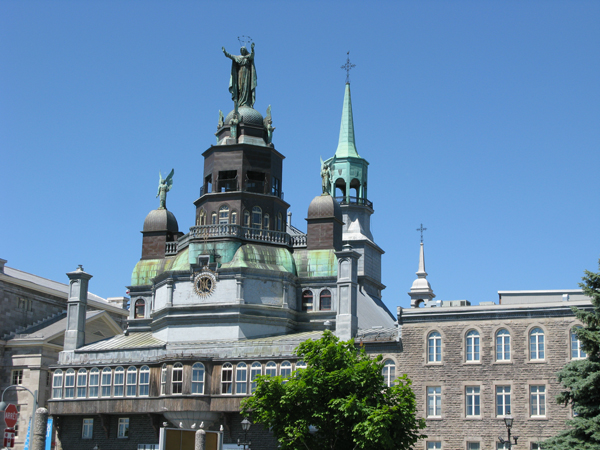
Rear of the Chapel - As Imposing As the Facade
We spent the rest of the morning wandering around the Vieux Ville taking in the buidlings and the French atmosphere before arriving at the Place d'Armes.

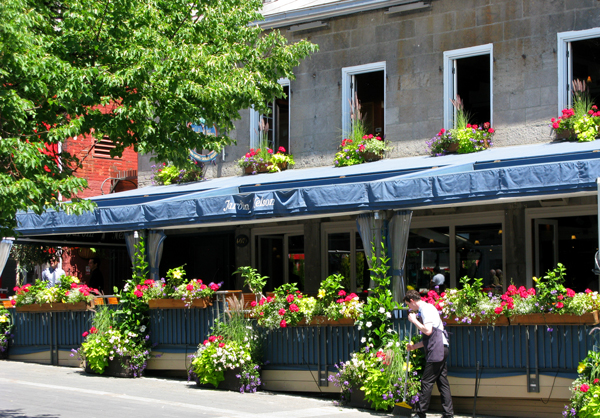
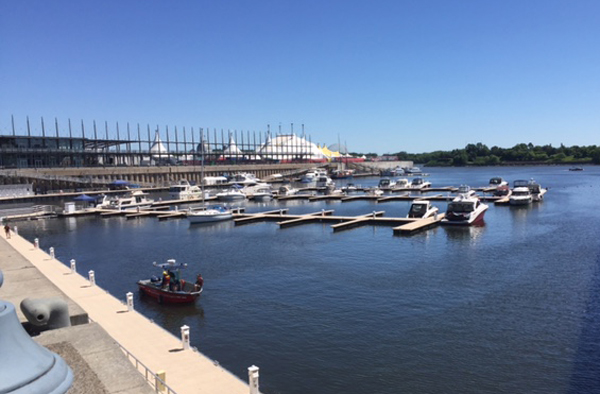
Where We Should Have Stayed - Just a Few Seasonals Left Who Chose to Stay
-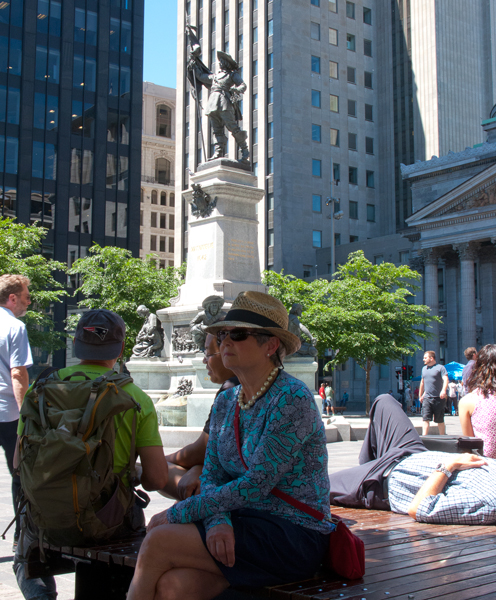
Taking a Break at the Place d'Armes with Maisoneuve,
One of the Founders Of Montreal,in the Background
The next stop was Chappelle Notre Dame du Sacre-Coeur at the Place d'Armes for a tour.
By 1800, original church on the site had become too small, and the Fabrique decided to build the church that exists today. To design the new church, the building council engaged the services of the New York architect James O’Donnell – himself an Irish Protestant by origin. O’Donnell and the Fabrique opted for the Gothic Revival style then in vogue in England and the United States. The main construction work took place between 1824 and 1829 and today seats over 2000 people.
O’Donnell did not live to see his work completed. He died in Montreal in 1830. Just prior to his death, he had converted to Catholicism, and was buried in the new church’s crypt, where his grave is marked by a plaque.
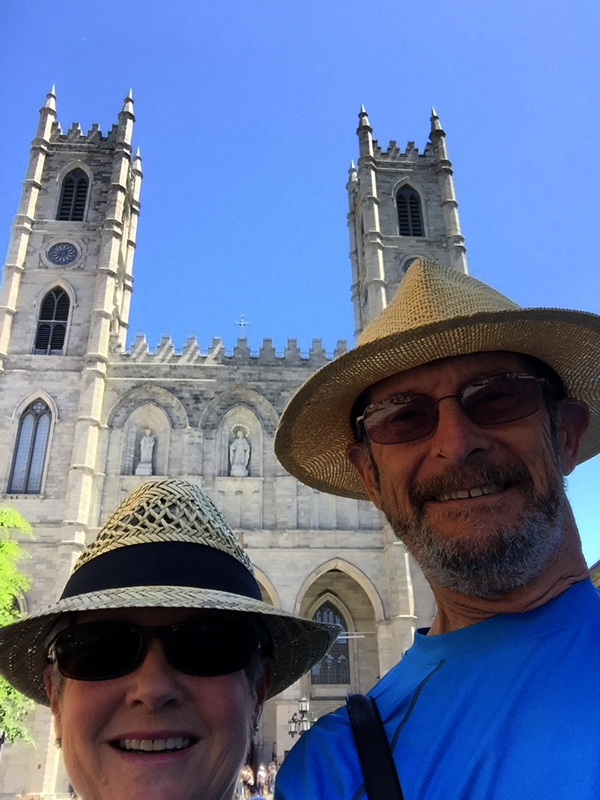

In 1889, Curé Léon-Alfred Sentenne commissioned the architects Perreault and Mesnard to build a chapel that would accommodate ceremonies for smaller congregations, such as marriages and funerals. Named the Chapel of Notre-Dame du Sacré-Cœur (Our Lady of the Sacred Heart) and consecrated on December 8, 1891, the date of the feast of the Immaculate Conception, it was built in Gothic Revival style with a wealth of sculptural motifs. The chapel was destroyed by fire and rebuilt in a more modern design with emphasis on natural light. Spectacular!!
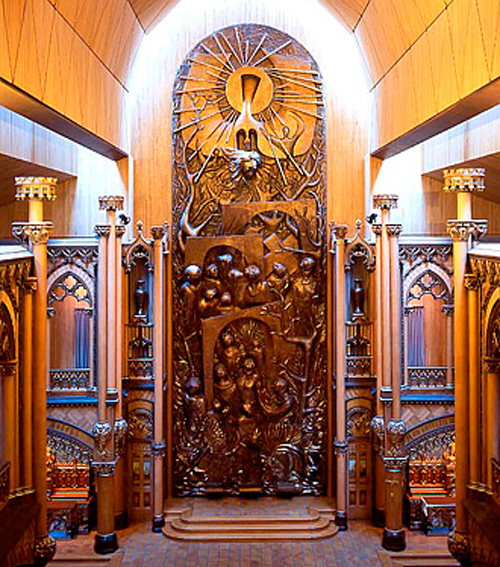
Between 1870 and 1900, the second phase of decoration of the church was the work of Curé Victor Rousselot and Victor Bourgeau, Quebec’s most active architect of that era. While travelling in France, Rousselot had been deeply impressed by the style and symbolism of the Sainte-Chapelle in Paris, which he proposed as a source of inspiration for Bourgeau. The decoration consists entirely of sculpted and painted wood.
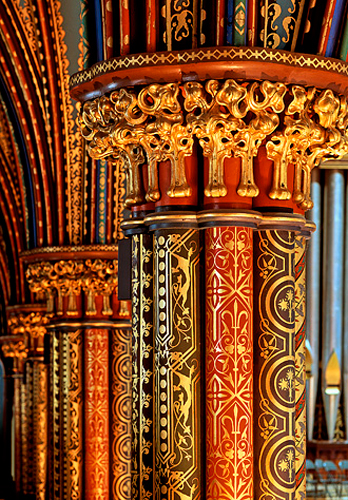
The rest of the day was spent absorbing the Vieux Ville before heading for the Atwater Market, one of a number of historic indoor markets in Montreal, typically seen in Europe. This turned out to be a food lover's paradise with multiple butchers, cheesemakers, vegetable and fruit vendors, gourmet stalls, and bakeries - the place to shop for fresh, local goods.
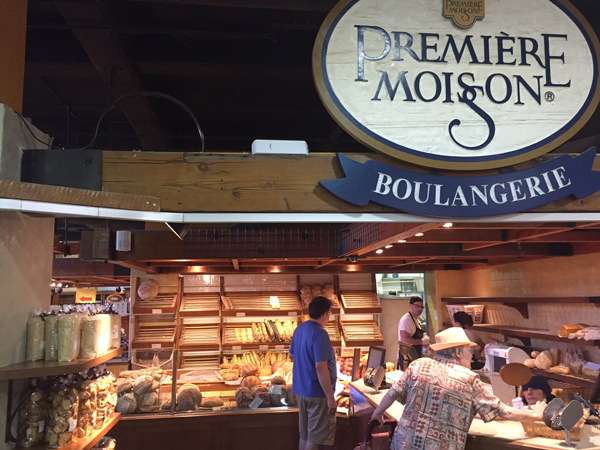
Back to the boat for the evening.Oh - and the park.
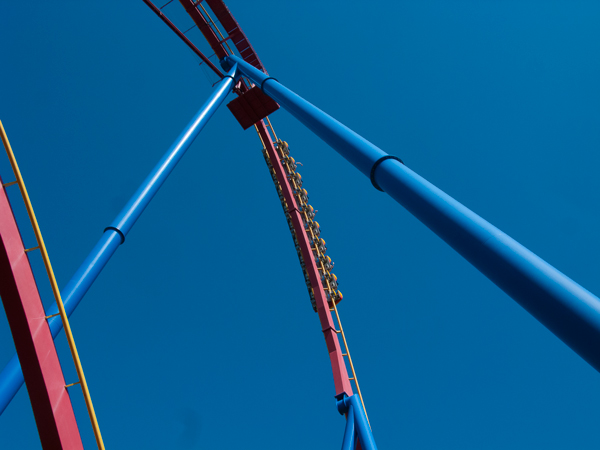
A Dizzying Ride in Front of the Boat
Friday, June 17
The great weather continues and the Three Amigos split up with Fran, Stephen, Bob and Jan going in to Montreal to take the horsedrawn carriage ride while we searched out the Montreal Museum of History. We did not realize there were two Museums and ended up at the smaller of the two, the Center of Montreal History at the Place d'Youville. What the heck, we checked it out anyway and ended up spending several hours there.
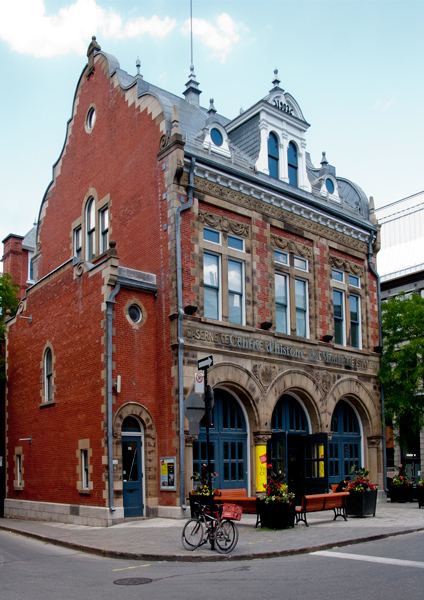
The Centre is housed in one of the first permanent Fire Stations of Montreal, a liitle bit of the beaten track. The first floor had a number of displays showing the history of the area from the Ice Age; through the first human habitation; the first arrival of the French explorers; and the gradual immigration of the French, the English, and the Irish to make Montreal what it is today. A very good overview!
The second floor had a large exhibit, "Scandal! Vice, Crime, and Morality in Montreal" that portrayed Montreal in the 1920s, 30s, and 40s when Montreal acquired the reputation of a city of pleasure with an exuberant nightlife, where North-American tourists could come to enjoy themselves, drink, and go slumming without fear of raids or arrests. Besides the all-night bars, there were countless restaurants, movie theatres, nightclubs, and cabarets in the city.

The city of glamour also included the underside of crime and illicit activities. The “Paris of North America” was one of the last cities on the continent to still have a functioning red-light district during the Second World War. Hundreds of brothels operated openly, a few yards away from the best-known nightclubs. Gambling dens and bookmaking counters proliferated downtown and spread to the four corners of the city, enriching gangs who were also involved in heroin trafficking.
The police weren’t doing enough to reassure honest citizens until the occurrence of shocking events provoked a major scandal but it took the Caron Inquiry (1950-1953), where the highest municipal authorities were accused of having "allowed" themselves to be corrupted by organized crime. These revelations allowed young reformist politicians like Jean Drapeau, elected mayor in 1954, to come into power on their promises to clean up, modernize, and democratize Montreal. At the same time, the increased use of the automobile, the expansion of the suburbs, and the advent of television sealed the fate of the city’s downtown nightlife.
The top floor showed "Griffintown: an original portrait", an exhibition that took us into the neighbourhood of Griffintown, through the lives and memories of the Mercier family. This French family had always lived in what was often considered an Irish, anglophone part of town. Their life stories took us down the streets of an industrial sector that has undergone quite a change during their lifetime from an industrial/working class neighborhood to new condo towers, stylish restaurants and boutiques.
Sitting below downtown and along the Lachine Canal, Griffintown is one of the oldest industrial and working-class neighbourhoods in Montreal. Today, only vestiges from its not-too-distant past linger in the shadow of new condo towers, stylish restaurants and trendy boutiques.
G. Scott MacLeod, a multidisciplinary artist , provided much of the work for the exhibit including oral histories he collected, videos, as well as his visual art to provide a window into this once-prosperous community and delivered a moving portrait of life “In Griffintown”.
Before we knew it three hours had passed and we were ready for lunch and picked La Gargote, a French restaurant just across from the Centre. Turned out to be a good choice with excellent soup and baked haddock as their lunch of the day.
Saturday, June 18
Took off early into Montreal to visit the Pointe-a-Calliere, Montreal Museum of Archeology and History, where we intended to go yesterday but didn't quite make it. Bob and Jan took a day off and Stephen and Fran headed out to anchor in a spot recommended by some of the locals at La Ronde.
Pointe-à-Callière Museum is a museum of archaeology and history in Old Montreal. It was founded in 1992 as part of celebrations to mark Montreal's 350th birthday. The museum has collections of artifacts from the First Nations of the Montreal region that illustrate how various cultures coexisted and interacted, and how the French and British regimes influenced the history of this territory over the years.
The museum complex comprises three archaeological sites: Pointe-à-Callière, Place Royale and 214 Place d'Youville; the archaeological field school at Fort Ville-Marie; Montreal's first Catholic cemetery; the William collector sewer; an archaeological crypt: Place Royale; a heritage building: the former Youville Pumping Station; 165-169 Place d’Youville the Mariners House and archaeological collections of over a million objects.

The Royal Insurance Company
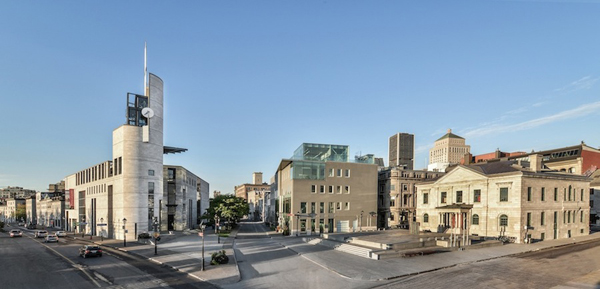
The Pointe-a-Calliere
The Pointe-à-Callière, a modern version of the previous Royal Insurance Company building, stands above several historic and archaeological sites of national significance, showcasing major periods in the history of Montreal. Some of the archaeology exposed during construction of the building has been left in situ as part of the museum's permanent display on the history of the city. The museum was constructed on pilings to leave existing finds undisturbed and protected.
The main entrance of the Museum rises above the point of land where Paul de Chomedey, Sieur de Maisonneuve, Jeanne Mance and other French settlers landed in 1642.

First Cemetery in Montreal Where 35 Early Settlers Were Interred
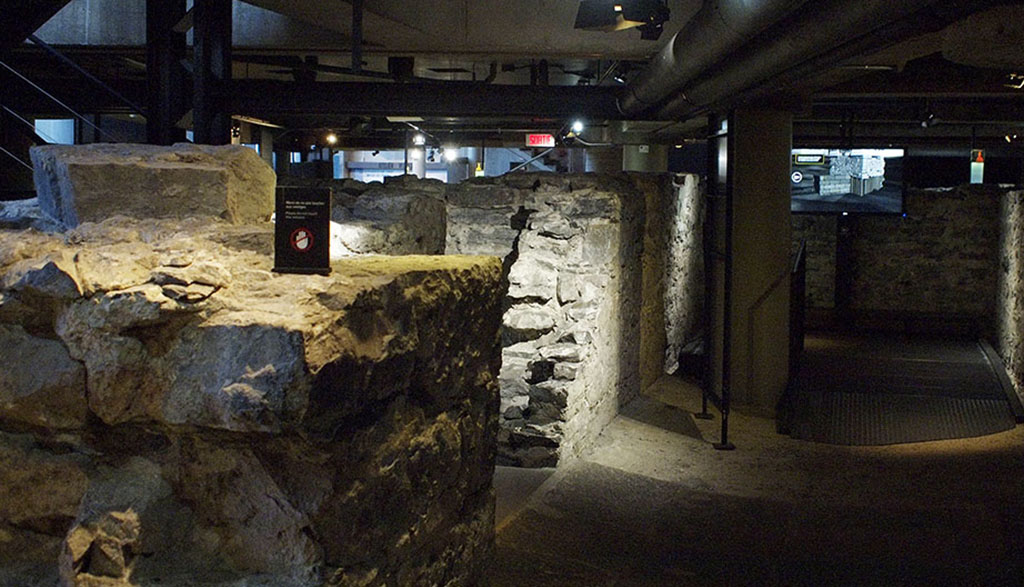
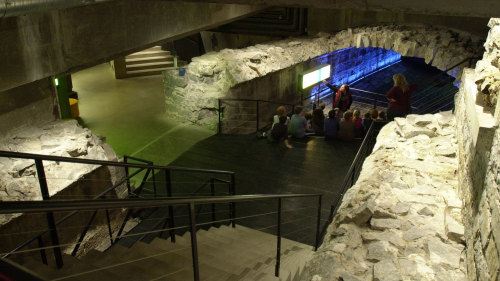
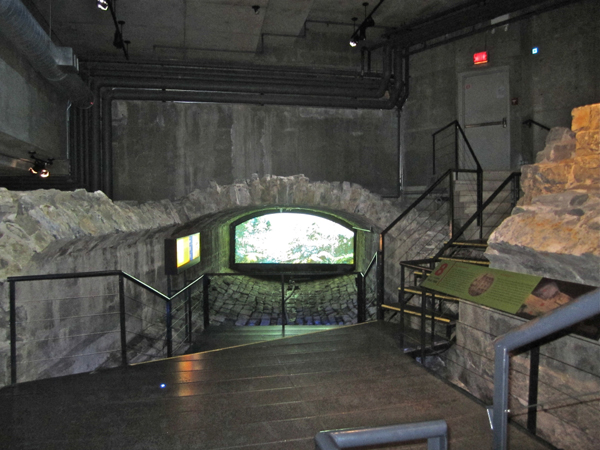
Where the Petit River Flowed
In an adjacent part of the Museum, a special exhibit called "Of Horses and Men", based on the private collection of Émile Hermès, the former head of Hermès International. The exhibit includes about 250 remarkable objects on loan from the Émile Hermès Collection, normally housed in private rooms at the company’s prestigious Parisian shop at 24 Rue du Faubourg Saint-Honoré. The collection recounts the story of the horse and its relationship to people. To date, only a lucky few outside the company have ever visited the collection.
Founded in Paris in 1837, Hermès International began as a maker of harnesses and saddles at a time when horses ruled the streets. Under the leadership of the founder’s grandson Émile Hermès (1871–1951), the firm truly took off, adapting its products to the new lifestyles of an elite clientele. A sign of wealth and power, the horse was long associated with the monarchy, nobility, bourgeoisie, and prestigious racing stables. But as the automobile began to replace the horse in daily life, the saddle maker-turned-leather merchant and avant-garde couturier realized the urgency of preserving the precious treasures of equestrian heritage.
Émile Hermès was able to transfer the traditional values and know-how involved in making saddles to creating high-quality leather and other goods such as the famed Hermes scarves.
We were able to see an outstanding collection of horse paintings and drawings; saddlery, horse-related leather work and harnesses made for the rich and royalty including the Czar of Russia; Hermes leather work interiors on several carriages; and the company's transition to leather luggage and couture. Unfortunately, I was too absorbed to take photographs of some of the fine craftsmanship but needless to say it was perfection.
Our day concluded with a long walk back to the Metro where we continued to see how all Montreal has managed to retain the old blending it with the new. Below is a classic example of this.
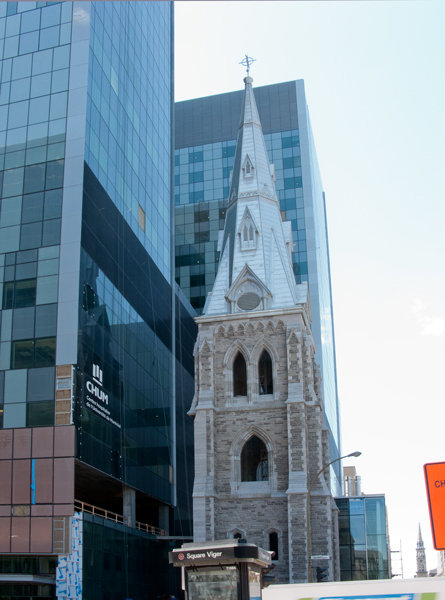
Sunday, June 19
Will be another hot day with temps around 90 deg. F so it will be a good day to be inside at the Musee de Beaux-Arts de Montreal.
Took the now familiar walk to the shuttle bus from La Ronde to the Metro - the bus drivers will know us by the time we leave! Soon arrived at our station but got turned around with multiple exits. Asked a guy in my imperfect French where the Musee was and he replied "I'm frightfully sorry but I don't know but I am going there later in the day and have a map we could look at," in a very plummy British accent. We are everywhere.
Back on course, we again passed a bakery that looked interesting so we stopped for a light breakfast and coffee. Just as well as it is a historic bakery that opened in the 1950s and is still run by the same family. They load the oven a minimum of five times a day, seven days a week, so their bread is always fresh. They had a good cartoon on the wall that sums up their dedication to fine breads and rolls.

The Musee is located in an area of Montreal that appeared to be more like a typical city center, different from the business and historic districts we had seen to date, with the usual high end stores and "brownstone" type buildings that were once residences now small boutiques and cafes - a very attractive area.
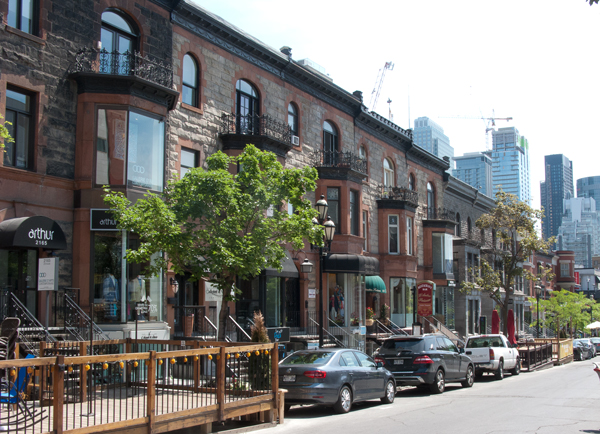
Like the Art Institute in Chicago, its scale is somewhat overwhelming and so we had to be very selective on what to see. The Museum now occupies three buildings, one very modern, as it has grown over the past 100 years.
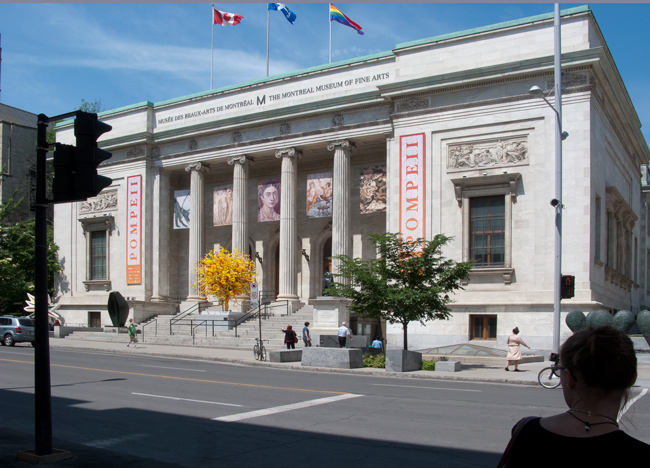
There were three exhibits of interest we decided to focus on - Pompeii, a world travelling exhibit of the story of destruction of Pompeii with many artifacts; another world exhibit of over 100 works of Toulouse-Lautrec, including some very rare prints; and a movie on the life of Mies van der Rohe, the architect. All three were excellent and took most of the day. Next Sunday is a "free day," so we plan to return to see some of the other special exhibits and browse the Permanent Collection.
The presentation of Pompeii is a unique experience that immerses you in the daily life of the Roman town before the cataclysmic eruption of Mount Vesuvius on August 24, 79 A.D. The exhibition incorporates archaeological artifacts from Pompeii within the market place, the home and garden, environments that have been re-created using state-of-the-art visual effects and soundscapes. The exhibition concludes with a multimedia re-creation of the volcanic eruption that buried Pompeii under meters of ash for centuries.
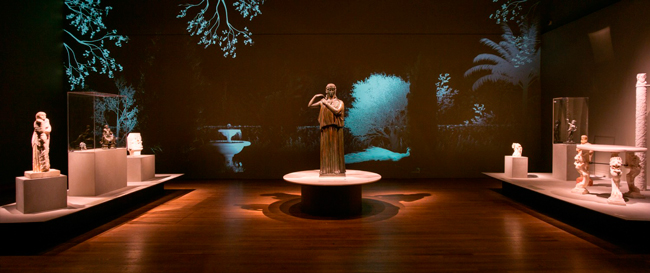
Part of The Pompeii Exhibit
: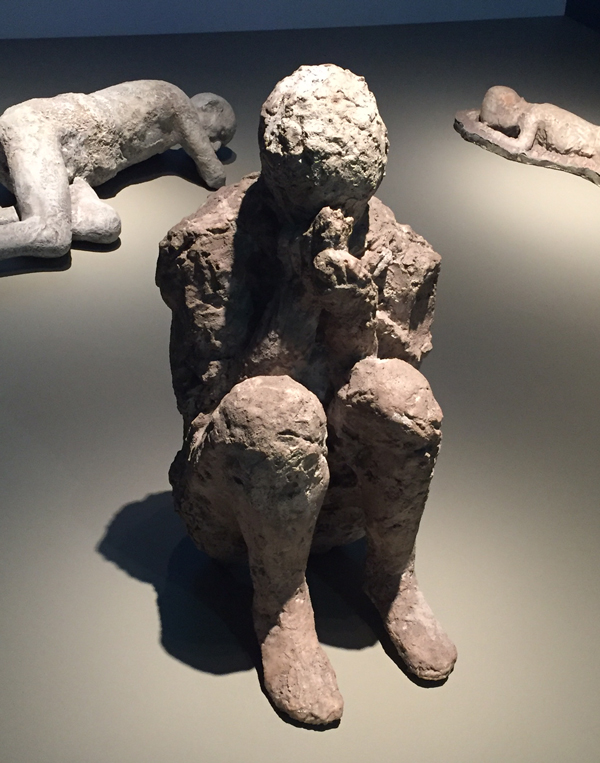
Casts of Ash Voids Where Pompeiians Were Trapped by Falling Ash
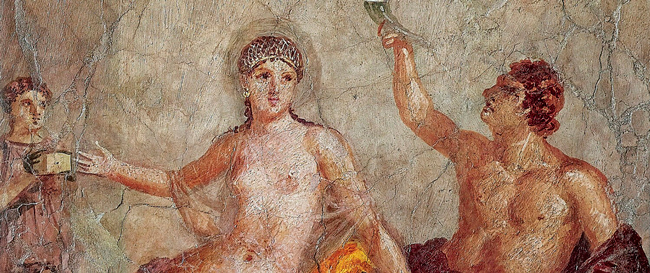
Large Fresco
In his less-than-20-year career, Toulouse-Lautrec created:
- 737 canvased paintings
- 275 watercolours
- 363 prints and posters
- 5,084 drawings
- some ceramic and stained glass work
A significant number of these were on display at the Museum with the emphasis on his drawings and lithographs. Interestingly, the exhibit included a number of lithographs showing the keystone (base) print and subsequent printings with the different colors.
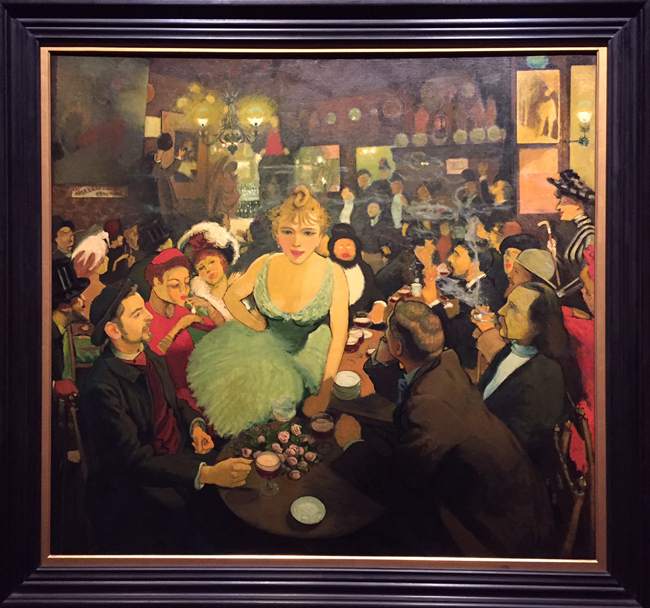
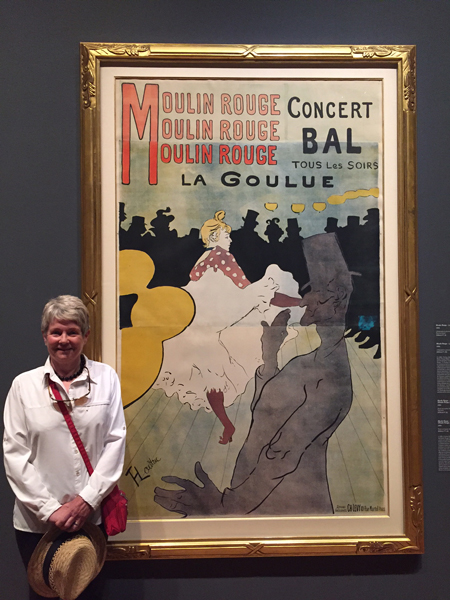
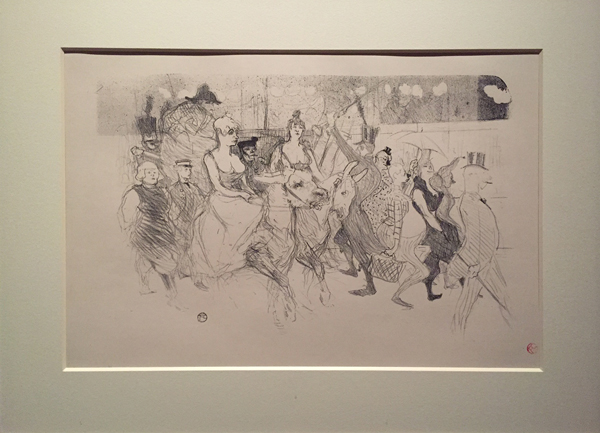
Together with documentation of Mies van der Rohe's life, the film showed all of his major buildings, as well as rare film footage of Mies explaining his philosophy. Phyllis Lambert related her choice of Mies as the architect for the Seagram building. Mies's achievements and continuing influence are debated by architects Robert A.M. Stern, Robert Venturi, and Philip Johnson, by former students and by architectural historians. The film also included Mies in rare documentary footage of his tenure as head of the School of Architecture at Armour Institute the forerunner of the Illinois Institute of Technology.
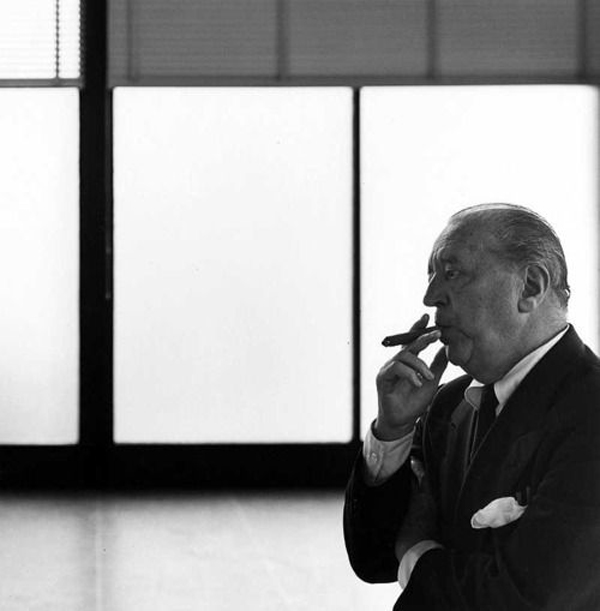
Mies
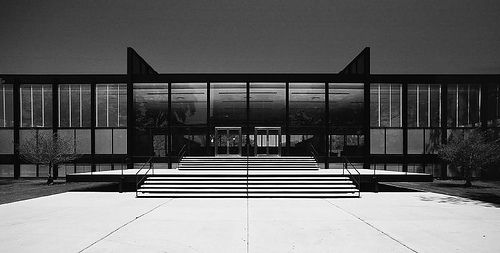
Illinois institute of Technology
It was a little cool in the Museum, 68 deg. F so it was good to get out in 90 deg and warm up - we will dress accordingly Sunday! A visit to the bakery to pick up our bread and rolls completed the day before the trek back to the boat and a game of Five Kings with Bob and Jan.
May 16 - 22 |
May 23 - 29 |
May 30 - Jun 5 |
Jun 6 - 12 |
Jun 13 - 19 |
Jun 20 - 26 |
Jun 27 - Jul 3 |
Jul 4 - 10 |
Jul 11 -17 |
Jul 18 - 24 |
Jul 25 - 31 |
Aug 1 - 7 |
Aug 8 - 14 |
Aug 15 -21 |
Aug 22 - 28 |
Aug 29 - Sep 4 |
Sep 5 - 11 |
Sep 12 - 18 |
Sep 19 - 25 |
